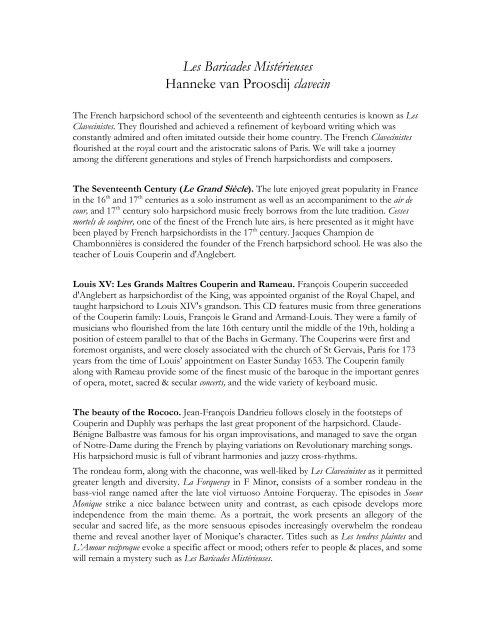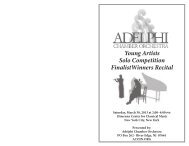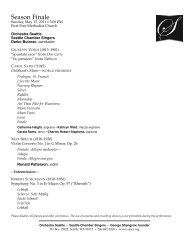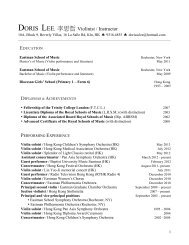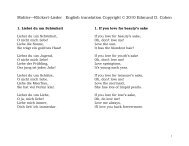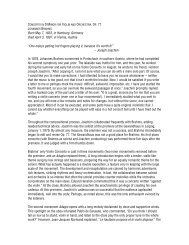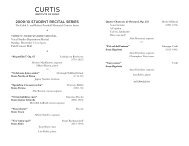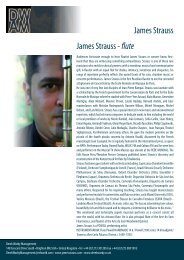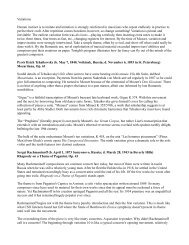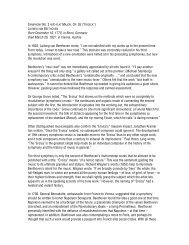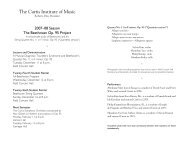Les Baricades Mistérieuses Hanneke van Proosdij ... - InstantEncore
Les Baricades Mistérieuses Hanneke van Proosdij ... - InstantEncore
Les Baricades Mistérieuses Hanneke van Proosdij ... - InstantEncore
You also want an ePaper? Increase the reach of your titles
YUMPU automatically turns print PDFs into web optimized ePapers that Google loves.
<strong>Les</strong> <strong>Baricades</strong> <strong>Mistérieuses</strong><br />
<strong>Hanneke</strong> <strong>van</strong> <strong>Proosdij</strong> clavecin<br />
The French harpsichord school of the seventeenth and eighteenth centuries is known as <strong>Les</strong><br />
Clavecinistes. They flourished and achieved a refinement of keyboard writing which was<br />
constantly admired and often imitated outside their home country. The French Clavecinistes<br />
flourished at the royal court and the aristocratic salons of Paris. We will take a journey<br />
among the different generations and styles of French harpsichordists and composers.<br />
The Seventeenth Century (Le Grand Siècle). The lute enjoyed great popularity in France<br />
in the 16 th and 17 th centuries as a solo instrument as well as an accompaniment to the air de<br />
cour, and 17 th century solo harpsichord music freely borrows from the lute tradition. Cesses<br />
mortels de soupirer, one of the finest of the French lute airs, is here presented as it might have<br />
been played by French harpsichordists in the 17 th century. Jacques Champion de<br />
Chambonnières is considered the founder of the French harpsichord school. He was also the<br />
teacher of Louis Couperin and d'Anglebert.<br />
Louis XV: <strong>Les</strong> Grands Maîtres Couperin and Rameau. François Couperin succeeded<br />
d'Anglebert as harpsichordist of the King, was appointed organist of the Royal Chapel, and<br />
taught harpsichord to Louis XIV's grandson. This CD features music from three generations<br />
of the Couperin family: Louis, François le Grand and Armand-Louis. They were a family of<br />
musicians who flourished from the late 16th century until the middle of the 19th, holding a<br />
position of esteem parallel to that of the Bachs in Germany. The Couperins were first and<br />
foremost organists, and were closely associated with the church of St Gervais, Paris for 173<br />
years from the time of Louis’ appointment on Easter Sunday 1653. The Couperin family<br />
along with Rameau provide some of the finest music of the baroque in the important genres<br />
of opera, motet, sacred & secular concerts, and the wide variety of keyboard music.<br />
The beauty of the Rococo. Jean-François Dandrieu follows closely in the footsteps of<br />
Couperin and Duphly was perhaps the last great proponent of the harpsichord. Claude-<br />
Bénigne Balbastre was famous for his organ improvisations, and managed to save the organ<br />
of Notre-Dame during the French by playing variations on Revolutionary marching songs.<br />
His harpsichord music is full of vibrant harmonies and jazzy cross-rhythms.<br />
The rondeau form, along with the chaconne, was well-liked by <strong>Les</strong> Clavecinistes as it permitted<br />
greater length and diversity. La Forqueray in F Minor, consists of a somber rondeau in the<br />
bass-viol range named after the late viol virtuoso Antoine Forqueray. The episodes in Soeur<br />
Monique strike a nice balance between unity and contrast, as each episode develops more<br />
independence from the main theme. As a portrait, the work presents an allegory of the<br />
secular and sacred life, as the more sensuous episodes increasingly overwhelm the rondeau<br />
theme and reveal another layer of Monique’s character. Titles such as <strong>Les</strong> tendres plaintes and<br />
L’Amour reciproque evoke a specific affect or mood; others refer to people & places, and some<br />
will remain a mystery such as <strong>Les</strong> <strong>Baricades</strong> <strong>Mistérieuses</strong>.
Instruments made by the Ruckers family in Antwerp were both rebuilt and copied by the<br />
great Parisian makers, in a fiercely competitive quest for the ideal harpsichord for solo<br />
repertoire. With an expanded compass of five octaves, a lighter keyboard action, and two<br />
independent manuals, these new instruments were perfectly suited to the technical and<br />
expressive demands of <strong>Les</strong> Clavecinistes. The instrument played on this CD exemplifies the<br />
tradition; it was made in 1996 in Amsterdam by Joop Klinkhamer after the remarkable<br />
instrument by Ruckers and later Goujon (1632/1742) currently in the Musée d'Art et<br />
d'Histoire in Neuchâtel, Switzerland. Its tonal palette is both dark and transparent with clear<br />
articulation. 2x8' 1x4' FF-f''' A=392.<br />
Please visit <strong>Hanneke</strong> at<br />
www.hanneke<strong>van</strong>proosdij.com<br />
www.voicesofmusic.org


